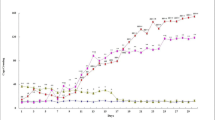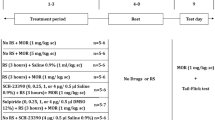Abstract
The present study examined the ability of pretreatment with MK-801 or haloperidol to block the induction of behavioral sensitization to amphetamine challenge by repeated immobilization stress in male Sprague-Dawley rats. Fifteen minutes before each of ten 30-min restraint sessions, rats were administered saline, MK-801 (0.01, 0.10 or 0.25 mg/kg IP) or haloperidol (0.10 or 0.25 mg/kg IP). Control rats received the same injection regimen without restraint. An additional experiment examined the ability of MK-801 to block the induction of sensitization by repeatedd-amphetamine. In this experiment, rats were administered saline or MK-801 (0.25 mg/kg IP) 15 min before each of ten amphetamine injections (1.0 mg/kg IP, administered under the same regimen as immobilization stress). Four days after the final immobilization or amphetamine injection, rats were tested for locomotor response to novelty, saline andd-amphetamine (1.5 mg/kg IP). Exposure to repeated immobilization stress significantly enhanced the locomotor response to amphetamine challenge but not to saline challenge whether rats were pretreated with saline, MK-801 or haloperidol. Secondary analysis of dose effects in each pretreatment group revealed that at 0.25 mg/kg, repeated MK-801 in itself induced sensitization to the response to amphetamine in control rats and potentiated stress-induced sensitization in restrained rats. In contrast, the sensitization induced by repeated amphetamine was attenuated by MK-801 pretreatment. Neither dose of haloperidol affected the locomotor response to saline or amphetamine in control or stressed rats. These results indicate that the effects of MK-801 on the induction of sensitization are complex and suggest that amphetamine-and stress-induced behavioral sensitization may arise through different mechanisms.
Similar content being viewed by others
References
Antelman SM, Eichler AJ, Black CA, Kocan D (1980) Interchangeability of stress and amphetamine in sensitization. Science 207:329–331
Cador M, Cole BJ, Koob GF, Stinus L, Le Moal M (1993) Central administration of corticotropin releasing factor induces long-term sensitization tod-amphetamine. Brain Res 606:181–186
Carey RJ, Dai H, Krost M, Huston J (1995) The NMDA receptor and cocaine: evidence that MK-801 can induce behavioral sensitization effects. Pharmacol Biochem Behav 51[4]:901–908
Carlsson M, Carlsson A (1989) The NMDA antagonist MK-801 causes marked locomotor stimulation in monoamine-depleted mice. J Neural Transm 75:221–226
Costall B, Naylor RJ (1977) Mesolimbic and extrapyramidal sites for the mediation of stereotyped behavior patterns and hyperactivity by amphetamine and apomorphine in the rat. In: Ellinwood EH, Kilbey MM (eds) Cocaine and other stimulants. Plenum Press, New York, pp 47–76
Deroche V, Piazza PV, Casolini P, Maccari S, Le Moal M, Simon H (1992a) Stress-induced sensitization to amphetamine and morphine psychomotor effects depend on stress-induced corticosterone secretion. Brain Res 598:343–348
Deroche V, Piazza PV, Maccari S, Le Moal M, Simon H (1992b) Repeated corticosterone administration sensitizes the locomotor response to amphetamine. Brain Res 584:309–313
Ellinwood EH, Sudilovsky A, Nelson LM (1973) Evolving behavior in the clinical and experimental (model) amphetamine psychosis. Am J Psychiatry 130:1088–1093
Hamamura T, Fibiger HC (1993) Enhanced stress-induced dopamine release in the prefrontal cortex of amphetamine-sensitized rats. Eur J Pharmacol 237:65–71
Herman J-P, Stinus L, Le Moal M (1984) Repeated stress increases locomotor response to amphetamine. Psychopharmacology 84:431–435
Hooks MS, Kalivas PW (1994) Involvement of dopamine and excitatory amino acid transmission in novelty-induced motor activity. J Pharmacol Exp Ther 269:976–988
Ichikawa J, Meltzer HY (1992) The effect of chronic atypical antipsychotic drugs and haloperidol on amphetamine-induced dopamine release in vivo. Brain Res 574:98–104
Kalivas PW, Alesdatter JE (1993) Involvement ofN-methyl-d-aspartate receptor stimulation in the ventral tegmental area and amygdala in behavioral sensitization to cocaine. J Pharmacol Exp Ther 267:486–495
Kalivas P, Stewart J (1991) Dopamine transmission in the initiation and expression of drug- and stress-induced sensitization of motor activity. Brain Res Rev 16:223–244
Karler R, Calder LD, Chaudhry IA, Turkanis SA (1989) Blockade of “reverse tolerance” to cocaine and amphetamine by MK-801. Life Sci 45:599–606
Karler R, Chaudhry IA, Calder LD, Turkanis SA (1990) Amphetamine behavioral sensitization and the excitatory amino acids. Brain Res 537:76–82
Kuribara H (1994) Early post-treatment with haloperidol retards induction of methamphetamine sensitization in mice. Eur J Pharmacol 256:295–299
MacLennan AJ, Maier SF (1983) Coping and stress-induced potentiation of stimulant stereotypy in the rat. Science 219:1091–1093
Mattingly BA, Hart TC, Lim K, Perkins C (1994) Selective antagonism of dopamine D1 and D2 receptors does not block the development of behavioral sensitization to cocaine. Psychopharmacology 114:239–242
Maurice T, Vignon J, Kamenka JM, Chicheportiche R (1991) Differential interaction on phencyclidine-like drugs with the dopamine uptake complex in vivo. J Neurochem 56:553–559
Mele A, Cabib S, Oliverio A (1995) Effects of the NMDA antagonist, MK-801, on stress-induced alterations of dopamine-dependent behavior. Psychopharmacology 117:313–317
Pauly JR, Robinson SF, Collins AC (1993) Chronic corticosterone administration enhances behavioral sensitization to amphetamine in mice. Brain Res 620:195–202
Piazza PV, Deminiere J-M, Le Moal M, Simon H (1989) Factors that predict individual vulnerability to amphetamine self-administration. Science 245:1511–1513
Piazza PV, Deminiere J-M, Le Moal M, Simon H (1990) Stress-and pharmacologically-induced behavioral sensitization increases vulnerability to acquisition of amphetamine self- administration. Brain Res 514:22–26
Piazza PV, Maccari S, Deminiere J-M, Le Moal M, Mormede P, Simon H (1991) Corticosterone levels determine individual vulnerability to amphetamine self-administration. Proc Natl Acad Sci USA 88:2088–2092
Post RM (1975) Cocaine psychoses: a continuum model. Am J Psychiatry 132:225–231
Reimer AR, Martin-Iverson MT (1994) Nimodipine and haloperidol attenuate behavioral sensitization to cocaine but only nimodipine blocks the establishment of conditioned locomotion induced by cocaine. Psychopharmacology 113:404–410
Robinson T, Becker J. Enduring changes in brain and behavior produced by chronic amphetamine administration: a review and evaluation of animal models of amphetamine psychosis. Brain Res Rev 11:157–198
Roth RH, Tam SY, Yang JX, Deutch A (1988) Stress and the mesocorticolimbic dopamine system. Ann NY Acad Sci 537:138–147
Segal DS, Kuczenski R, Florin SM (1995) Does dizocilpine (MK-801) selectively block the enhanced responsiveness to repeated amphetamine administration? Behav Neurosci 109:532–546
Snell LD, Yi SJ, Johnson KM (1988) Comparison of the effects of MK-801 and phencyclidine on catecholamine uptake and NMDA-induced norepinephrine release. Eur J Pharmacol 145:223–226
Snyder SH (1973) Amphetamine psychosis: a “model” schizophrenia mediated by catecholamines. Am J Psychiatry 130:61–67
Sorg BA, Kalivas PW (1991) Effects of cocaine and footshock on extracellular dopamine levels in the ventral striatum. Brain Res 559:26–31
Stewart J, Druhan JP (1993) Development of both conditioning and sensitization of the behavioral activating effects of amphetamine is blocked by the non-competitive NMDA receptor antagonist MK-801. Psychopharmacology 110:125–132
Thierry AM, Tassin JP, Blanc G, Glowinski J (1976) Selective activation of mesocortical dopamine system by stress. Nature 309:350–352
Vezina P, Stewart J (1989) The effect of dopamine receptor blockade on the development of sensitization to the locomotor activating effects of amphetamine and morphine. Brain Res 499:108–120
Wedzony K, Czyrak A (1994) The role of corticosteroids in the acquisition of sensitization to locomotor stimulant effects of MK-801. Brain Res 657:351–356
Weiss SRB, Post RM, Pert A, Woodward R, Murman D (1989) Context-dependent cocaine sensitization: differential effect of haloperidol on development versus expression. Pharmacol Biochem Behav 34:655–661
Wolf ME, Jeziorski M (1993) Coadministration of MK-801 with amphetamine, cocaine, or morphine prevents rather than transiently masks the development of behavioral sensitization. Brain Res 613:291–294
Wolf ME, Khansa MR (1991) Repeated administration of MK-801 produces sensitization to its own locomotor stimulant effects but blocks sensitization to amphetamine. Brain Res 562:164–168
Wolf ME, White FJ, Hu XT (1994) MK-801 prevents alterations in the mesoaccumbens dopamine system associated with behavioral sensitization to amphetamine. J Neurosci 14:1735–1745
Author information
Authors and Affiliations
Rights and permissions
About this article
Cite this article
Tolliver, B.K., Ho, L.B., Reid, M.S. et al. Evidence for dissociable mechanisms of amphetamine-and stress-induced behavioral sensitization: effects of MK-801 and haloperidol pretreatment. Psychopharmacology 126, 191–198 (1996). https://doi.org/10.1007/BF02246448
Received:
Revised:
Issue Date:
DOI: https://doi.org/10.1007/BF02246448




